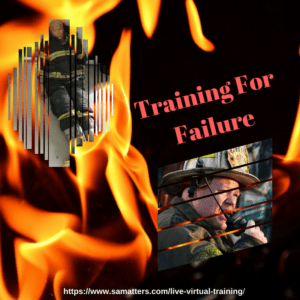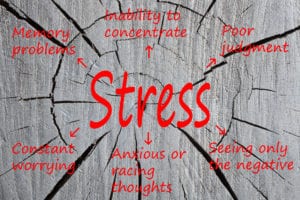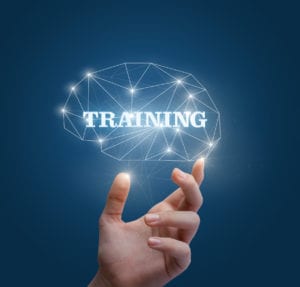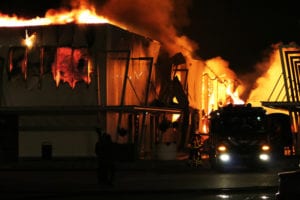 Since I announced the release of the Training for Failure live program (and the DVD recording of the program) I have received a lot of emails from firefighters and training officers asking me to tell them more about the program’s content so I thought I’d share with you a snip-it of the catastrophically important content discussed in that program.
Since I announced the release of the Training for Failure live program (and the DVD recording of the program) I have received a lot of emails from firefighters and training officers asking me to tell them more about the program’s content so I thought I’d share with you a snip-it of the catastrophically important content discussed in that program.
Is it possible to erode firefighter situational awareness and to train a firefighter to fail? You bet it is! I see it all the time. I should clarify that previous statement a little. It see it NOW… all the time.
There was a time when I didn’t see it. In fact, I was one of those instructors who were training firefighters to fail. I didn’t realize I was doing it. No instructor would train a firefighter to fail on purpose. But, accidentally, it’s happening all the time and the consequences can be catastrophic.
 In my Mental Management of Emergencies program I share with firefighters how easy it is to be trained to fail. Experienced officers and trainers alike have called this program a “wake up call” and I could not agree more. As I was conducting my research about how the brain functions under stress I had an epiphany. We’re training first responders to fail! It was a punch in the gut for me because I knew how many times I had provided flawed training to firefighters and EMS providers throughout my 30 years.
In my Mental Management of Emergencies program I share with firefighters how easy it is to be trained to fail. Experienced officers and trainers alike have called this program a “wake up call” and I could not agree more. As I was conducting my research about how the brain functions under stress I had an epiphany. We’re training first responders to fail! It was a punch in the gut for me because I knew how many times I had provided flawed training to firefighters and EMS providers throughout my 30 years.
Let me share just one of many examples of how this can happen. But before I do, I’d like to offer you some B.S. (Brain Science). This will help improve your understanding of how firefighters are being trained for failure.

B.S. Law #1: The stressed brain does not make decisions the same way as the non-stressed brain.
The lesson here is the non-stressed brain is a calm, rational thinking brain. It’s not under a lot of pressure so it can readily process information and figure out solutions to problems rather readily. The stressed brain… not so rational. In fact, just watching the apparent dumb things firefighters do when they are under stress would lead some people to surmise the stressed brain is irrational. The stressed brain isn’t irrational in its decision making. It is intuitive.
 B.S. Law #2: Under stress, the brain runs automatic scripts.
B.S. Law #2: Under stress, the brain runs automatic scripts.
The lesson here is the stressed brain compels the body to become a creature of habit. The brain will instruct the body to perform exactly how it was programmed to perform based mostly on memorization and repetition. This is true when recalling cognitive information (like people’s names and email addresses). It is also the case with muscle memory (the physical movements tied to performing a task). Practice does not make perfect. Practice makes permanent.
 B.S. Law #3: Muscle memory results from muscle movement.
B.S. Law #3: Muscle memory results from muscle movement.
The lesson here is muscles memory is formed from actual physical movement, not from the storage of information about how to move. Talking about how to perform a demanding physical task is not the same as doing it. You can tell a firefighter all day long how to throw a ladder. But the brain does not store the memory of the actual movements until the muscles move and raise the ladder.
A practical application of the brain laws
Those are but three of dozens of lessons that are important for instructors to understand but let’s see how just those three can result in a firefighter being trained for failure.
Here’s the scenario. The instructor is going to conduct a live burn training evolution at the burn building. The crews arrive and everything is set up and the instructor conducts a pre-incident briefing of the day’s activities and objectives. Hose lines and water supplies are secured. The burn team is in place and… “Fire in the hole” send the first team in!
The first team advances with a 1 ¾” line and they locate the fire and knock it down. They back out and the instructor team critiques their behavior. Each consecutive team does the same thing and this goes on for several hours and each team gets 6 evolutions on the line.
The instructors feel good because they know that repetition builds skills and these firefighters got some good training. The students feel good because they know they gained valuable experience and are now better prepared for structural firefighting. This is where the lessons of brain science and the fire service collide in a way that can have catastrophic consequences.
You see, the well-intended instructors, for the sake of expediency, never required each attack team to conduct a 360-degree size up around the burn building to develop their situational awareness before they engaged in the structural firefight. Why?
One of the most logical reasons is the burn building is constructed of concrete and steel. It’s NOT going to fall down on the attack team and everyone, including the instructors, knows that. Everyone there has a comfort level with the stability of the structure. It’s built to be burned in for goodness sake. So teams are not required to complete a 360-degree size up before starting each evolution.
Each team that enters the burn building advances a 1 ¾” hose line to the fire and knocks it down. Fire isn’t large enough to require a 2 ½” in hose line. The smaller 1 ¾” line is adequate and appropriate. The firefighters become very proficient with advancing their 1 ¾” line and they are rewarded with success every time.
As firefighters practice these skills, the three laws from brain science are at work. The stress of the training causes the firefighters to think intuitively, not rationally. They are developing their automatic scripts (both cognitive and muscle memory). Under stress at a real structure fire, the firefighters are going to perform exactly how the scripts in their brains tell them to perform.
Have you ever seen or heard of an incident where a firefighting crew arrived on a fire that should have been a defensive (exterior) attack yet they went offensive (inside) the structure only to find themselves in a world of trouble quick? You could readily see they should not have gone inside. But for some reason, they didn’t see it the same way and, like fools, they rushed in. Were they being foolish? They certainly didn’t seem to be acting rational. That’s because they weren’t acting rational. They were acting intuitive. (That’s Brain Law #1).
The firefighters arrive and “go” into a well-involved fire that any competent firefighter would readily say was a “no-go” fire (i.e., the firefighters do not go in for it would mean catastrophic consequences). Why would the firefighters enter a “no-go” environment and jeopardize their lives? Because that’s what they were trained to do… “go!” In fact, it is absolutely rare for firefighters to be trained on the physical and cognitive tasks associated with “no-go.” So when the firefighters arrive, they go in. They ALWAYS go in because their brains are running automatic scripts (That’s Brain Law #2).
The firefighters that arrive and “go” into the well-involved fire are yet vulnerable to another major consequence. If the fire is “no-go” it is probably going to be a large fire that requires large water. But the poor firefighting team does not pull a 2 ½” line. They pull the 1 ¾” hose line and advance it into a fire whose potential far exceeds the capacity of their small hose line. Big fire requires big water. That’s so… rational. So why would these firefighters not pull the larger line? Because muscle memory has been built up over numerous practice evolutions. The muscles know… a structure fire gets attacked with a 1 ¾” line. The muscle movement of practice over time has built muscle memory. (That is Brain Law #3).
 The catastrophic results
The catastrophic results
Put it all together and what do you have?
Firefighters arriving at well-involved structures, failing to complete a 360-degree size up causing flawed situational awareness. By not practicing the complete size-up they are missing the important lessons of how to assess building construction, fire and smoke conditions. The fire may be defensive but they don’t see it as a defensive fire. Because in their minds, the script reads every fire is an offensive fire.
They advance small hose lines into fires that need big hose lines because they have only practiced with small hose lines. Even if, during training, the instructor were to say “Now remember, if you have a big fire, you need to pull a big hose line” this will not work. It is a rational statement being made to a rational mind. Of course it’s going to make sense. The students may even let out a collective “No duh!” in response as if to indicate such a simple concept did not need to be iterated
It’s not what the instructor says that will dictate the performance. It’s what the student does that will determine it.
Dr. Gasaway’s Advice

Here are some tangible recommendations for fixing these problems.
- Build a 360-degree size up into every evolution. Don’t just have them walk around for the sake of walking around. Have them say what they are looking for as it relates to building construction, building decomposition, fire and smoke conditions.
- Practice pulling 2 ½” lines in training. Even if the training fire is too small for a large line, practice pulling and using the larger line.
- Discuss and train firefighters on what “no-go” conditions look like. What the building decomposition would look like. What the fire conditions would look like. What the smoke conditions would look like.
- Train firefighters on the physical tasks to be performed when a fire is a “no-go” fire so they know, physically, what they should do.
_____________________________________________________

If you are interested in taking your understanding of situational awareness and high-risk decision making to a higher level, check out the Situational Awareness Matters Online Academy.
CLICK HERE for details, enrollment options and pricing.
__________________________________
Share your comments on this article in the “Leave a Reply” box below. If you want to send me incident pictures, videos or have an idea you’d like me to research and write about, contact me. I really enjoy getting feedback and supportive messages from fellow first responders. It gives me the energy to work harder for you.
Thanks,

Email: Support@RichGasaway.com
Phone: 612-548-4424
SAMatters Online Academy
Facebook Fan Page: www.facebook.com/SAMatters
Twitter: @SAMatters
LinkedIn: Rich Gasaway
Instagram: sa_matters
YouTube: SAMattersTV
iTunes: SAMatters Radio
iHeart Radio: SAMatters Radio

Once again I must thank you. Your insights into how the brain functions under stress seem quite obvious (in many examples) and yet they are so often overlooked or ignored.
Thanks for posting all this great information.
Dave,
Thanks for the feedback. I appreciate it very much. I am trying very hard to get valuable information into the hands (or I should say minds) of first responders. Please help spread the word about the Situational Awareness Matters! website and newsletter.
Rich